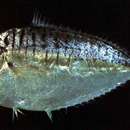ar
الأسماء في صفحات التنقل


Die Slankglipvis (Secutor insidiator) is 'n vis wat in die wes Indiese-Pasifiese area en aan die ooskus van Afrika tot by die Oos-Kaap voorkom. In Engels word die vis Slender ponyfish genoem.
Die vis het geen skubbe op die kieue nie en die snoet is opwaarts gevorm.
Die Slankglipvis (Secutor insidiator) is 'n vis wat in die wes Indiese-Pasifiese area en aan die ooskus van Afrika tot by die Oos-Kaap voorkom. In Engels word die vis Slender ponyfish genoem.
Secutor insidiator, the pugnose ponyfish or barred ponyfish, is a species of ray-finned fish, a ponyfish in the family Leiognathidae.[2] The barred ponyfish's mineralized skeleton contains apatite and the mineralized tissue contains hydroxylapatite.[4] They have bare heads with nuchal spines and their bodies are a distinctive, reflective silver, frequently imitated by fishermen using silver lures. They have a protracted mouth pointing upward and the tip of the maxilla reaches well below the level of the lower margin of the eye. Barred ponyfish feed on zooplankton, including larval fishes and crustaceans.[5] Body depth is twice or slightly more than standard length, which measures 11.3 cm from the tip of the snout to last vertebra.[6] The lateral line ends before the dorsal fin.[7]
Secutor insidiator was first formally described in 1781 as Zeus insidiator by Marcus Elieser Bloch with the type locality given as Surat in India. Henry Weed Fowler named it as the type species of the genus Deveximentum. Some authorities regard the name Secutor to be a synonym of Leiognathus and that the genus should use Fowler’s name.[3]
Secutor insidiator is found in the Indo-Pacific from the Red Sea, Persian Gulf and East Africa In the Indian Ocean to Australia, New Caledonia and Tahiti In the western Pacific Ocean.[2]
This species is known to feed on phytoplankton, polychaeta (bristle worms), Noctiluca (sea sparkle), and Coscinodiscus.[4]
The barred ponyfish is known to be eaten by bluefish, Spanish mackerel, saurida, and several species of bonito. It is also used as bait by fishermen to capture larger fish which prey on the barred ponyfish.[4] it has been observed to be consumed by predatory fish such as Barramundi, several species of snapper and species of grouper; however, due to its small size, abundance and minimal defense mechanisms, it is prey for various fish. [8] It is sold for human consumption in markets across Asia, commonly used in the "fried ponyfish" dish.[9]
Secutor insidiator lives in shallow waters, close to the bottom and it can occasionally be found in brackish waters.[2]
Barred ponyfish are a delicacy in many parts of Asia such as Pakistan, China, most prevalently consumed throughout the Philippines, most commonly cooked whole, marinated in sauce and fried in oil. This recipe varies, as it is cooked with hot spices in Pakistan. [10] This fish is sold in fish markets across Asia, due to its abundance and lack of resources needed to capture it. [11]
This fish has been observed to be captured with cast nets by fishermen who are surf fishing, as barred ponyfish have been seen swimming in shoals off the coasts of Singapore.[12] However, commercial fishing boats catch them for sale in large fish markets across Asia. Barred ponyfish are thought to migrate to estuaries with brackish water for purposes such as breeding and/ or feeding, and they can be caught using 'Tamban Rigs' as they are often called by local Singaporean fishermen, which consists of a long 1 metre main line with several small hooks attached to it, anchored by a lead sinker, commonly caught from a bridge or jetty.[13]
Secutor insidiator, the pugnose ponyfish or barred ponyfish, is a species of ray-finned fish, a ponyfish in the family Leiognathidae. The barred ponyfish's mineralized skeleton contains apatite and the mineralized tissue contains hydroxylapatite. They have bare heads with nuchal spines and their bodies are a distinctive, reflective silver, frequently imitated by fishermen using silver lures. They have a protracted mouth pointing upward and the tip of the maxilla reaches well below the level of the lower margin of the eye. Barred ponyfish feed on zooplankton, including larval fishes and crustaceans. Body depth is twice or slightly more than standard length, which measures 11.3 cm from the tip of the snout to last vertebra. The lateral line ends before the dorsal fin.
Secutor insidiator Secutor generoko animalia da. Arrainen barruko Leiognathidae familian sailkatzen da.
Espezie hau Agulhasko itsaslasterran aurki daiteke.
Secutor insidiator Secutor generoko animalia da. Arrainen barruko Leiognathidae familian sailkatzen da.
Secutor insidiator is een straalvinnige vissensoort uit de familie van ponyvissen (Leiognathidae).[1] De wetenschappelijke naam van de soort is voor het eerst geldig gepubliceerd in 1787 door Bloch.
Bronnen, noten en/of referenties静鲾(学名:Secutor insidiator),長吻仰口鰏、靜仰口鰏,为鲾科仰口鲾属的鱼类,俗名金钱、金钱仔、花令仔、榕叶仔。分布于印度洋北部沿岸、东至印度尼西亚、菲律宾以及中国南海、台湾海峡等海域,属于热带和亚热带沿岸暖水性上层鱼类。该物种的模式产地在印度苏拉特。[1]
本魚與仰口鰏相似,但其體長卵形,標準體長為體高的2至3倍。頭部無特殊斑點,體側上方有藍色小點,形成若干橫帶,體側下方有小暗點,背鰭末端黑色。背鰭硬棘8枚、軟條16枚;臀鰭硬棘3枚、軟條14枚。體長可達15公分。
本魚在岸邊至近海之沙泥底海床上皆可發現其蹤影。常成群覓食小型無脊椎動物。